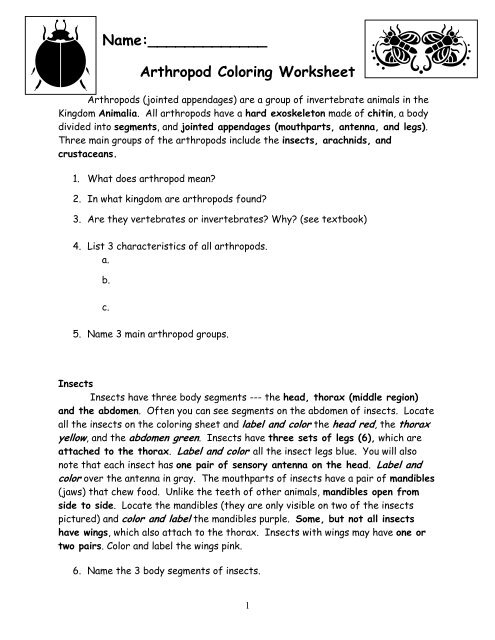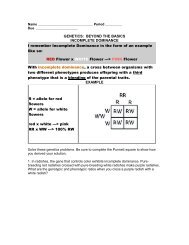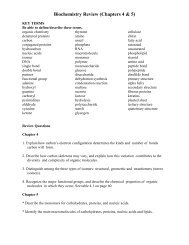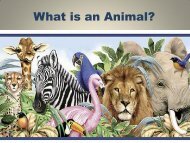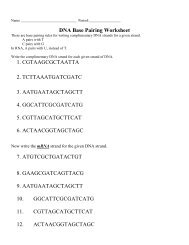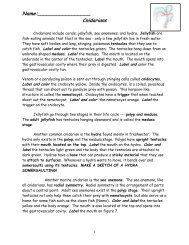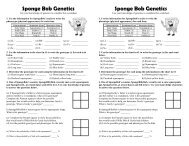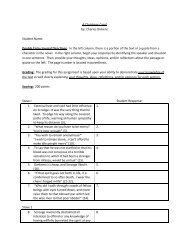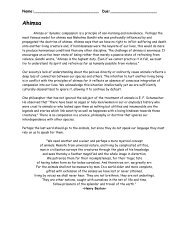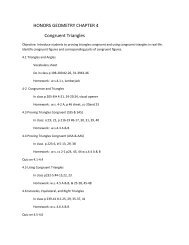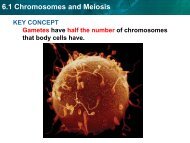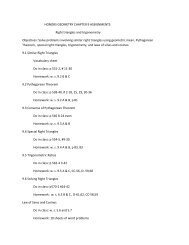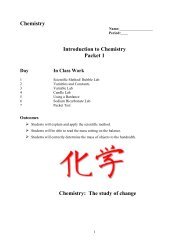Arthropod Coloring Worksheet
Arthropod Coloring Worksheet
Arthropod Coloring Worksheet
Create successful ePaper yourself
Turn your PDF publications into a flip-book with our unique Google optimized e-Paper software.
Name:_____________<strong>Arthropod</strong> <strong>Coloring</strong> <strong>Worksheet</strong><strong>Arthropod</strong>s (jointed appendages) are a group of invertebrate animals in theKingdom Animalia. All arthropods have a hard exoskeleton made of chitin, a bodydivided into segments, and jointed appendages (mouthparts, antenna, and legs).Three main groups of the arthropods include the insects, arachnids, andcrustaceans.1. What does arthropod mean?2. In what kingdom are arthropods found?3. Are they vertebrates or invertebrates? Why? (see textbook)4. List 3 characteristics of all arthropods.a.b.c.5. Name 3 main arthropod groups.InsectsInsects have three body segments --- the head, thorax (middle region)and the abdomen. Often you can see segments on the abdomen of insects. Locateall the insects on the coloring sheet and label and color the head red, the thoraxyellow, and the abdomen green. Insects have three sets of legs (6), which areattached to the thorax. Label and color all the insect legs blue. You will alsonote that each insect has one pair of sensory antenna on the head. Label andcolor over the antenna in gray. The mouthparts of insects have a pair of mandibles(jaws) that chew food. Unlike the teeth of other animals, mandibles open fromside to side. Locate the mandibles (they are only visible on two of the insectspictured) and color and label the mandibles purple. Some, but not all insectshave wings, which also attach to the thorax. Insects with wings may have one ortwo pairs. Color and label the wings pink.6. Name the 3 body segments of insects.1
7. How many legs do insects have and which body segment are they attachedto?8. How many antennae do insects have and where are they located?9. Name the insect’s jaws and explain their movement.10. Do all insects have wings? Explain your answer.11. Where are wings attached to on an insect?Grasshoppers are a common type of arthropod. Read thedefinitions, then label and color the grasshopper anatomy diagram below:abdomen - the segmented tail area of a grasshopper, which contains the heart,reproductive organs, and most of the digestive system (red)antennae - like all insects, grasshoppers have 2 segmented antennae that sensetouch and odors (gray)compound eye - grasshoppers have 2 faceted eyes made up of many hexagonallenses (light green)head - the head is at the front end of the grasshopper's body and is the locationof the brain, the two compound eyes, the mouth parts, and the points ofattachment of its two antennae. (brown)jumping legs -the long, hindmost pair of the grasshopper's six legs (dark green)mandibles - the jaws, located near the tip of the head, by the palps; the jawscrush the food (purple)palps - long, segmented mouth parts (under the jaws) that grasp the food (violet)spiracles - a series of holes located along both sides of the abdomen; they areused for breathingthorax - the middle area of the grasshopper's body - where the legs and wingsare attached (tan)walking legs - the four, short front legs that are used for walking (yellow)wings - grasshoppers have two long wings, used for flying (light blue)2
Figure 1 - External Grasshopper AnatomyArachnidsArachnids are a group of arthropods that include spiders, mites, scorpions,and ticks. They have two body parts --- the cephalothorax (head and thoraxcombined)) and the abdomen. Label and color the cephalothorax orange and theabdomen green. Arachnids have 8 legs, instead of the 6 that you find in insects.Label and color the legs blue. Notice that arachnids do not have antennae, but youcan see the mandibles on the spider pictured. Label and color the mandiblespurple. Tiny eyes (also called ocelli) that can only detect light and dark are locatedon top of the spider's cephalothorax. Most species of spiders have 8 eyes, butother species have more. Label and color the ocelli red. Pedipalps, also calledpalps, are two sensory feelers that look like very short legs attached to the frontof the spider. Pedipalps help taste food. Label and color the pedipalps lightpurple. The spider’s jaws are also called chelicera. They are located below theeyes. The jaws are tipped with fangs that can inject poison. Label and color thechelicera or fangs brown. Spinnerets are where the spider's silk is released. Theyare located at the tip of the abdomen. Label the spinnerets.22. List members of the arachnid group.23. How many body sections do arachnids have? Name them.3
24. On which section are the eyes and mouthparts located?25. How many legs do arachnids have?26. Do arachnids have compound eyes like insects? Explain your answer.27. What can ocelli detect?28. How many eyes do most spiders have?29. What are pedipalps and describe their appearance?30. How do spiders taste their food?31. Spider jaws are also called ________________ and have poison___________ at the tips.32. What organ produces silk for webs?Figure 2 – External Arachnid (Spider)4
CrustaceansCrustaceans are a group of arthropods that mainly live in the water; theyinclude lobsters, crabs, shrimp, and crayfish. Crustaceans usually have two bodysegments --- the cephalothorax (orange) and the abdomen (green). The number ofjointed appendages for movement & feeding on crustaceans can vary. Many ofthem have large claws called chelipeds used for capturing prey. Label and colorthe claws or chelipeds on the lobster brown. Walking legs are attached to thethorax. Label and color the walking legs blue. Notice the small, leg-likestructures called swimmerets attached to the underside of the abdomen on thelobster. The lobster uses these for swimming and holding eggs and young. Labeland color the swimmerets dark blue. Crustaceans also have sensory antenna.Label and color the antenna gray.33. Where do crustaceans live and name four?34. Crustaceans have different jointed ____________ for various jobs suchas feeding and moving.35. What are the large claws on crustaceans called & what is their purpose?5
36. Where are walking legs attached?37. Where are swimmerets located and name some functions for thesestructures?CentipedeCentipedes have long flat bodies and many legs. In fact, the word"centipede" means "hundred legs.” Centipedes actually have 4 or 2 pairs of legson each body segment. Label and color the legs of the centipede blue and eachof its body segments red. Centipedes have a pair of sensory antenna on thehead. Label and color the antenna gray. Centipedes are often poisonous and feedon insects or other arthropods. They have pincers at the posterior end forcapturing prey. Label and color the pincers orange.MillipedesMillipedes are often called 1,000-legged worms or rain worms. They are wormlikein appearance with rounded body segments that each bears two pairs of legs.Label and color the body segments brown and the legs black. The head is roundedwith short antennae. Label and color the head tan. Species can vary in lengthfrom less than 1 to 2 or more inches. They are light brown to black in color.Millipedes are not poisonous, but many species have glands capable of producingirritating fluids that may cause allergic reactions in some individuals. Thedefensive sprays of some millipedes contain hydrochloric acid that can chemicallyburn the skin and cause long-term skin discoloration.6
Circle the Answer38. Which is poisonous ---- millipedes or centipedes?39. Which has more legs per body segment --- millipedes or centipedes?40. Which has a flattened body --- millipedes or centipedes?41. Which produces an irritating acid --- millipedes or centipedes?Insect Life CycleMany insects go through developmental stages called metamorphosis.Dramatic physical changes of the insect’s body takes place in these stages. Someinsects do not go through metamorphosis and just increase in size. There are twomain types of metamorphosis --- complete and incomplete. The stages incomplete metamorphosis are: Egg --> Larva --> pupa ---> adult (example:butterflies). The stages in incomplete metamorphosis are: Egg --> nymph -->adult (example: crickets). The nymph looks like the adult insect but is smallerand the wings aren’t fully developed. Label the stages in each type ofmetamorphosis.In incomplete metamorphosis, the nymph develops from an egg and looks likethe adult, but it does NOT have fully developed wings. Color the nymph yellow andthe egg red. In complete metamorphosis, a worm-like stage called the larva orcaterpillar develops from the egg. This stage eats lots of vegetation storing foodenergy for the next stage. Color the eggs red and the caterpillar yellow. The larvaor caterpillar spins a cocoon or chrysalis in which the pupa develops into an adultinsect. Color the cocoon light green. The butterfly in the picture is a Monarch.Color the Monarch orange.42. What is metamorphosis?7
43. Name the two types.44. Name the complete metamorphosis stages.45. Name the incomplete metamorphosis stages.46. Describe nymphal insects.47. Why is the larva called the feeding stage? What is larva called?48. What is another name for the cocoon & what is its function?8


